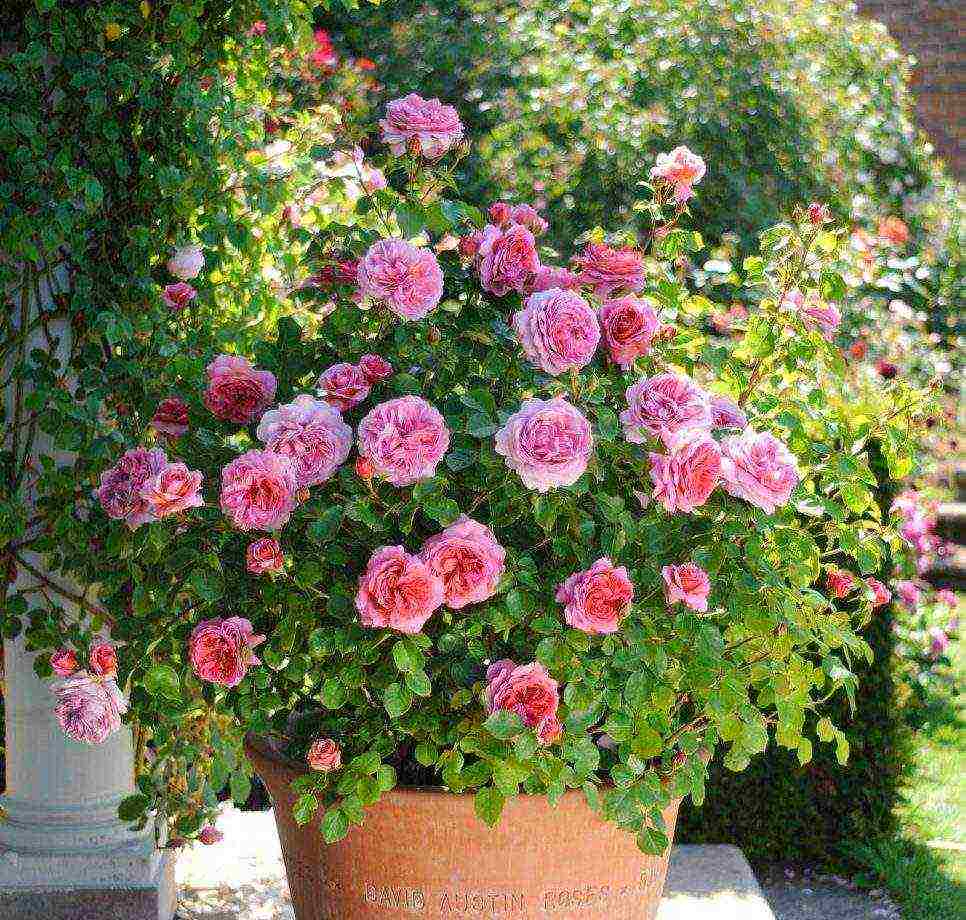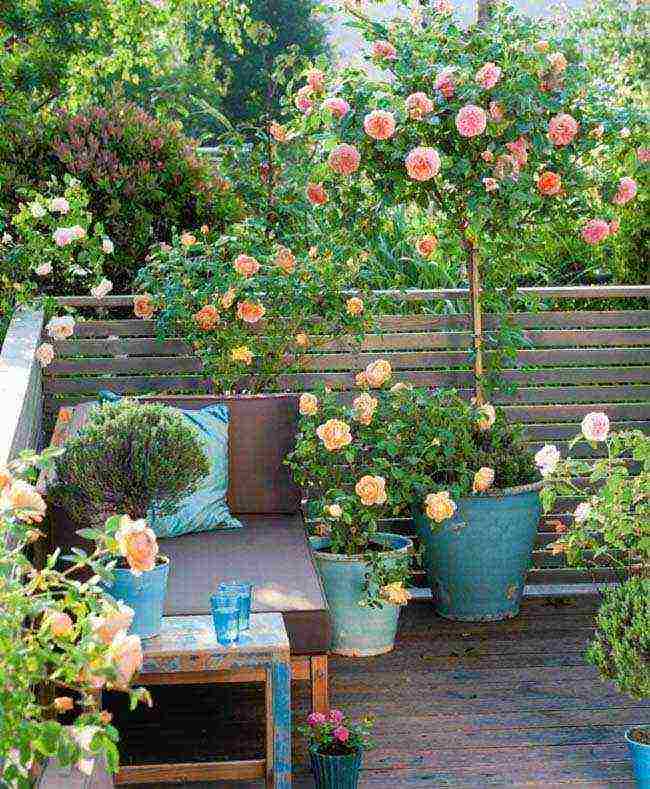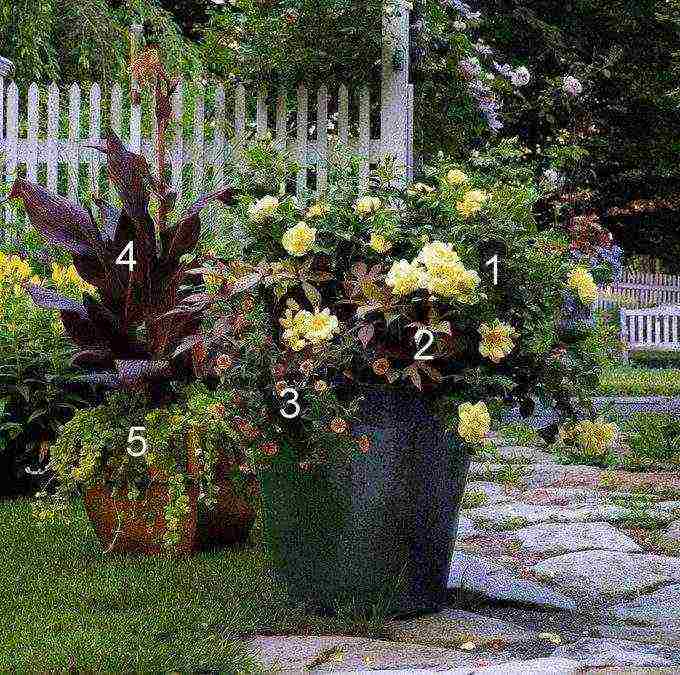Content
- 1 Patio roses: varieties and types
- 2 Video "Patio roses - your choice for patios"
- 3 Description of varieties
- 4 How to plant and care
- 5 Reproduction technique
- 6 Disease and pest control
- 7 Wintering conditions
- 8 Video "Variety of roses Patio"
- 9 Varieties
- 10 Landing
- 11 Care
- 12 How to buy seedlings correctly?
- 13 What to do after purchase?
- 14 Application in landscape design
- 15 Personal experience
These roses stand out from the undersized floribunda varieties. Their appearance has been known since the late 80s of the 20th century. The very name "patio" comes from the fashionable habit of decorating courtyards with pots of blooming roses. One of the creators of this wonderful type of roses was Patrick Dixon from Ireland.
Another name for these roses is "Roses of Miniflora". It was offered to the world by American rose growers in 1999. Thanks to American breeders, these roses have been allocated to a separate class, and now it has more than 2000 varieties and hybrids.
But in Europe this name did not take root. Here they are still called Patio roses, the varieties and types of which are striking in their diversity.
They could not be attributed to miniature roses, but at the same time they stood out for their size from other representatives of the floribunda.
The height of these bushes is from 45 to 55 centimeters. But these babies grow an abundance of flowers of various colors, collected in beautiful inflorescences. One wave of flowering replaces another, and this continues throughout the season.
Very often, these roses are used in garden design to decorate a mixborder. They look good in a flowerbed in front of the house and in pots or planters.
In the patio group, spray roses can be distinguished. In these roses, each branch is a whole bouquet. They can be used for cutting, they will stand for a long time in a vase of water.
Patio roses: varieties and types
BabyMaskerad. It is unpretentious, with a weak aroma, frost and drought resistant variety. Looks good in flower beds and in pots.
Baby Baccarat - France (Meilland). These roses look beautiful in pots in front of the house. They are bright and memorable.

LavenderJuel - USA (Moore) 1978. This is one of the most beautiful miniature roses with double mauve flowers. It blooms for a long time, but after the final disclosure, the flowers fade to a lilac hue.
Korsnoda. Very hardy white rose, resistant to many diseases.
MimiEden - France (Meilland). A wonderful two-tone rose with ivory petals on the outside and pink on the inside. In brushes of 8-10 pieces of flowers, which bloom alternately.
Lydia - Holland (Interplant) 1990. Light pink color, not double, the middle is visible through the petals.
Petito. Yellow rose with red stripes, unpretentious, disease-resistant.
Rumba - Denmark (Poulsen). A very beautiful variety, bred in 1959 and still popular among rose lovers.

Epricot Clementine - Germany (Evers). A rose with large apricot flowers will adorn any garden and home.
Another name for these roses is "border roses". Patio roses, varieties and types of which continue:
- AnnaFord. This rose has red-orange flowers with a yellow eye
- Gentle Touch. This rose is characterized by pale pink flowers
- Honeybunch. It is a variety with dense double flowers reminiscent of honey and a fragrant aroma.
- StrawberryFayre. Red and white striped flowers with a delicate scent. This rose has golden yellow flowers with petals slightly bent outward.
- Sunseeker. Scarlet flowers with a yellow center
- SweetMagic. The flowers of this rose are of an unusual color: golden yellow with orange streaks
Patio roses, their various varieties and types, will always attract attention with their endurance and the extraordinary beauty of endlessly blooming inflorescences.They can no doubt be called the little treasures of your garden!
Video "Patio roses - your choice for patios"
A wide variety of flowers can be grown in the garden and at home. However, roses are most often found on window sills and flower beds. Today they are presented in a wide variety of varieties. Recently, the patio mix rose has become increasingly popular among florists. Let's get to know the representatives of this variety better.
Description of varieties
At the end of the last century, Patio roses were singled out as an independent group. Despite this, in some catalogs, these plants are still classified as species such as miniature or Floribunda.
Patios were obtained as a result of breeding work on crossing curb and undersized varieties. The very first varieties were bred Marlena and Meteor.
These flowers are stunted. However, among the Patio, there are also taller representatives. They differ from other species in the shape of the leaf blade and flowers. For example, Patio flowers and leaves are smaller than Floribunda, but larger than miniature ones. Flowers differ in a variety of shapes and shades. They can be plain or terry. The largest specimens reached 5 cm in diameter.
The bush has compact dimensions. It grows up to 55 cm in height. Such plants are often grown on boles. Here you can achieve a height of 1 m from them.
Representatives of this variety are often used by designers to create landscape displays.
How to plant and care
To get good flowering from these roses, you need to properly plant and care for the bushes. Saplings can be planted in garden soil or in flower pots. In open ground, planting is carried out in early spring. Before transferring to the soil, the root system of the seedling should be opened and soaked for several hours in water.
Patio roses love open and sunny areas. In a place suitable for their growth, a hole should be dug with a diameter and depth of about 45 cm. A drainage (expanded clay or pebble) is placed on its bottom, which is covered with sand from above. Organic fertilizers should be placed on top of the sand layer. Grass and leaves will do. You can also add manure. After that, the plants are placed in a hole and covered with earth. Then the soil around the seedling is compacted
A room rose, after buying in a store, needs a mandatory transplant. This procedure is performed according to the same scheme as planting a purchased seedling in open ground. After planting, the plant should be well watered. For this, warm water is taken.
In order for a planted plant to take root, you need to know how to care for it correctly. Caring for representatives of the Patio variety, both in the garden and at home, is simple. However, despite this, there are several rules that must be remembered when growing such roses:
- the flower should be well lit during the day. It tolerates direct sunlight normally. But when transferred from home to garden, the plant must adapt to the new light regime. To prevent sunburn, roses should be shaded a little at noon;
- watering is performed regularly. However, the bay of the flower should be avoided. Spraying of leaves is allowed. For irrigation, only settled and warm water is taken;
- during the season, fertilizing is mandatory. Here you need to use fertilizers specially formulated for roses. Top dressing is applied carefully so as not to overdo it.
As you can see, caring for these flowers at home and in the garden really does not require a significant investment of time and effort. Any novice florist can cope with this task.
Reproduction technique
Patio can be propagated in two ways:
- cuttings;
- by grafting the shoot on the dog rose.
Both methods are quite popular, but cuttings are still used more often. They can be cut from the mother bush at any time.However, twigs cut at the beginning of summer take root best. A cut shoot should have a bud, flower, bud or stem.
The stalk takes root in moist and loose soil. Before planting, it can be placed in water until roots appear.
Disease and pest control
The planted rose bushes of this variety must be monitored so as not to miss the moment of the appearance of parasites or diseases. Most often, plants suffer from spider mites. Its presence is evidenced by a white bloom on the leaves and cobwebs. To combat it, various insecticidal agents are used (for example, "Aktara").
Flowers can be sore due to improper care, so care should always be optimal.
Wintering conditions
Garden roses of the Patio variety are transferred to the house for the winter. Although they can be left to winter in the garden. In this case, the bushes are covered with spruce branches. A wire frame is built around the plant, which is covered with a film on top. From mid-spring, such a structure should be opened for ventilation. The insulation is removed in the presence of an established warm weather.
When transferring a rose to the house for the winter, it should be additionally illuminated with fluorescent lamps. The room temperature should be at around +20 degrees. If these conditions are not met, then the flower will go into hibernation. For shallow sleep, you need a temperature of +15 degrees, and for deep sleep, +5 degrees.
Patio rose will be an excellent purchase, both for the garden and for the home. Minimal care of the bushes will allow you to achieve long and abundant flowering from the plants.
Video "Variety of roses Patio"
In this video, you will learn how to grow Patio Rose and other indoor varieties.
Patio roses have recently been singled out as a separate group. This only happened at the end of the 20th century. The shortest (but not all) roses were separated from the floribunda group roses, which received the name patio roses.
As a result of breeding work, the collection undersized or border roses replenished with new varieties. The very first include such varieties as Meteor, Marlena and others.
However, until now, patio roses are not always singled out as an autonomous group. For example, in flower catalogs, these varieties can be found among floribunda or miniature roses. The plant differs in size and shape of flowers and leaves. So, patios have less leaves and flowers than floribunda roses, but more than miniature roses.
These flowers are often used by landscape designers for planting in flower beds and mixborders, for decorating small gardens and outbuildings, as well as for planting in containers.
Patio roses represent small and compact bushes, the height of which does not exceed 55 cm... Very often they are grown on boles no more than 1 meter high, where they look very beautiful.
Flower shapes are varied, as are their colors. Depending on the number of petals, the flowers are double and simple. The largest flower has a diameter of about 5 cm, and the smallest - only 2.5 cm.
The patio group should also include spray roses. They differ in that the flowers are collected in large inflorescences. Such roses make magnificent bouquets.
Varieties
Milky Way - spray rose, the height of which does not exceed 60 cm. Differs in large flowers, the diameter can reach 8 cm. Flowers have a pleasant aroma and pale pink color. The variety is actively used for mixborders and flower beds, as well as for planting in containers and flowerpots.

Milky Way
Korsnoda - a spectacular variety with double white flowers, the diameter of which is no more than 5 cm. The height of the plant does not exceed 60 cm. The flowers do not have a pronounced aroma. These roses are great for flower gardens, mixborders, as well as for container planting. The variety is frost-resistant and disease-resistant.

Korsnoda
Rose spray Macarena- this is a plant no more than 60 cm high.The flowers have a delicate apricot color. Their diameter is about 5 cm. It is a varietal variety with a light aroma. Differs in resistance to diseases and frost.

Macarena
Pink Flash - a bright varietal variety of spray roses. Densely double flowers are distinguished by a juicy one-time color. Flowers can grow up to 10 cm in diameter. The plant has a height of about 60 cm. It has a pleasant light aroma. The variety has good frost resistance. The plant is an excellent solution for mixborders and flower beds.

Pink Flash
Rose Spray Summer (Summer) - This is a bright varietal variety of patio roses. The flowers are rich yellow. The flowers can be up to 8 cm in diameter. They have a light aroma. The plant is unpretentious and resistant to frost and disease.

Summer
Baby Baccara - patio roses with deep red flowers, the diameter of which does not exceed 6 cm. The plant grows up to 60 cm. This is an ideal solution for flower beds and container plantings. Looks good in bordering flower beds.

Baby Baccarat
Typhoon - spray rose with beautiful red flowers with a deep orange tint. The diameter of the flowers is about 5 cm. The height of the culture is about 70 cm. The variety is distinguished by its unpretentiousness to keeping conditions and resistance to frost. The variety is used for planting in containers and flower beds.

Typhoon
In Russia and not only, patio mix roses, Danica and Hit mix are very popular. These are low (about 30 cm) and compact bushes with double flowers of various colors.

These flowers are often grown in pots at home and in the garden, and are also planted in flower beds and flower beds. In the care of the plants, they are unpretentious. The varietal variety Gemeng (Monde Gemeng) is widespread.
How to care for such roses? There is nothing difficult about this. Even a beginner in floriculture can cope with the care of patio roses. Let's consider all the points in more detail.
Landing
It is recommended to plant seedlings in open ground in early spring. Before planting, the root system, if it is open, is recommended to soak for two to three hours in water.
For planting, it is recommended to choose a sunny and open area. The hole should be about 45 cm deep and in diameter so that the root system is spacious in it. At the bottom of the hole, it is necessary to make a drainage layer: small pebbles (pebbles, expanded clay or broken brick) are laid at the very bottom, and a little sand is poured from above.
It is recommended to put organic fertilizers on top of the drainage. Dry foliage, grass, or decay can be used. It is not superfluous to put a little manure on the bottom of the hole.
The seedling is planted in a hole, covered with the top layer of soil. The soil compresses well around it.
Important! If a rose seedling was purchased in a container, then it needs to be transplanted. A transplant after purchase is necessary and uncomplicated process... Initially, you need to carefully remove the rose from the container. The planting process itself is no different from the above.
It is recommended to make a small depression for water next to the rose bush. After the plant has been planted, it must be watered. One plant requires about 8 liters of water. For irrigation, you need to take warm water that has been heated by the rays of the sun. It is advisable to use rainwater. When using tap water, it is recommended to let it stand for a few days so that all the chlorine is released from it.

Care
Caring for patio roses is easy both at home and in the garden. How to care for the garden and at home?
Location
It is recommended to grow a culture in a bright place, be it a window, balcony or open ground. In garden plots, direct sunlight is not harmful to the rose. However, if it has been growing at home for a long time, then before transferring the plant to the garden, the flower will need to adapt to the rays of the sun. This also applies to newly purchased flowers.
To prevent sunburn at noon, when the sun is too bright, it is advisable to protect the plant from the rays. And so that the root system does not suffer from overheating, the pot can be placed in a large and light pots, or wrapped in white paper.
It is required to regularly ventilate the room. In a dark patio area, the rose will grow poorly and slowly, and may also refuse to bloom.
Watering and humidity
Watering the crop is required regularly. He should be moderate. It is not recommended to allow the soil to completely dry out between watering, only a slight drying of the top layer of the soil is allowed.
Stagnant water is also dangerous for the rose.... It can lead to decay of the root system, so the plant cannot be transfused. In addition, a drainage layer is required in the soil or at the bottom of the pot.
Spraying is allowed, but not in direct sunlight. This procedure will help you endure the heat and heat. However, over spraying can lead to the development of fungus.
Important! For irrigation, it is recommended to take exceptionally warm and settled water.
Top dressing
Top dressing must be applied throughout the spring-summer season. They are also allowed in winter, but only if there is additional lighting.
As top dressing, special fertilizers for roses are used. These can be purchased at flower shops. It is better to make top dressing often, but in small portions. This will improve assimilation and prevent soil oversaturation.
It is not recommended to start feeding the plant immediately after purchase. It is better to start fertilizing after 3 months. This is due to the fact that the roses on sale are already well enriched with special long-acting dressings. And additional application will cause salinization of the soil.
Wintering in the garden and indoors
For the winter, some dig up the plant and move it indoors for the winter, others leave the patio rose in the garden to winter. In this case, it is required to cover it with spruce branches. A wire frame is placed around the bush, which should be several centimeters higher than the bush itself. Material and polyethylene film are laid on it. Starting in mid-spring, the plants need to be ventilated, and soon the insulation is completely removed.
Since the rose often lacks natural light in winter, the use of artificial lighting lamps is recommended. In this case, the air temperature should be about 20 degrees. However, if such conditions cannot be ensured, then the plant can be sent to winter. Wintering can be deep or shallow.
For shallow sleep, the plant needs to provide a temperature of no higher than 15 degrees. And for deep sleep, the temperature is lowered to 5 degrees. However, the temperature needs to be lowered gradually. In deep sleep, the rose throws off the leaves, and the lack of light no longer scares her.
Pests
The plant is often affected by spider mites. You can find it by a whitish bloom in the form of a cobweb on the leaves. It is required to fight it with the help of insecticidal agents ("Aktara", "Aktellik", "Fitoverm" and others).
How to buy seedlings correctly?
When buying, you should pay attention to the appearance of the plant itself. The stems should not have black dots. The leaves should adhere firmly to the stems, be resilient and glossy.
Faded leaves are the cause of overheating of the culture, whitish bloom is a sign of a spider mite's damage to the plant, and brown spots signal the presence of a fungal infection.
You should also check the plant for pests.
The packaging must be of high quality. It needs information about the variety of the rose, the color of the flowers.
What to do after purchase?
Immediately after purchasing a patio rose in the store, you will need:
- Wash under a warm shower. This will remove dust from the rose and reduce the number of spider mites, if any;
- Gently remove the rose from the pot along with the earthen lump and transplant it into a larger pot with fresh soil, which is especially intended for roses;
- For the prevention of pests, the flower should be sprayed with Aktara solution;
- If the plant has signs of fungus, then it must be treated immediately with fungicides.
Application in landscape design
The culture is actively used by flower growers and landscape designers to decorate garden plots. Patio roses are great for low curbs, for good reason they are even called curbs. They look great in flower beds and flower beds, especially in the bordering of flower beds. Also good in mixborders.
In the photo below, flowers in pots in the garden. These pots are suitable for terraces:

Flowers look good in foregrounds in rose gardens. They are used to decorate the entrances to buildings, stairs and terraces. Also looks good on rocky slides and in resting corners.
Delicate cream and pink patio roses in containers and with a stem will make your veranda or loggia incredibly beautiful and elegant:

The photo shows patio roses in the garden in a container, formed by a trunk.
Container patio roses work great as a tapeworm, but there is nothing to limit the combination of similar plants with other container crops. The only caveat: it is worth choosing plants that do not interrupt the exquisite and "expensive" beauty of roses. Given that these are miniature roses, standard partners such as lavender, conifers and perennial herbs can be questionable - it is worth looking at individually whether a particular variety will withstand such partners. Compositions in containers will require known skill and careful planning.
The photo below is an example of a container composition:

Green pot in the foreground: 1. Yellow Roses, 2. Sweet Caroline Bronze Ipomoea, 3. Celebration Carpet Calibrachoa. In the yellow pot on the left: 4. tropical canna (Canna tropicana) and 5. lusimachia "Aurea".
These roses are often used for cutting. They make very beautiful bouquets, including wedding bouquets.
The culture is perfect for creating curbs, that is, decorating walls and fences. In the photo there are plants on boles and without them.
Personal experience
The video below shows a personal experience of growing compact roses in an apartment from Ekaterina Weber.
Undoubtedly, and has long been customary, that the rose is one of the most revered and beloved flowers. No wonder she is called the queen of all colors. It is truly one of the most beautiful and fabulously attractive plants.
As a symbol of love and beauty, roses will probably forever be the most revered among women. There is no sweeter and more delicate gift in the world than a bouquet of amazing roses.
But this bouquet brings positive emotions only at the beginning, when the flowers look beautiful in a vase and smell fragrant throughout the room. Some time passes and the flowers fade. And some kind of sediment appears on the soul. This phenomenon once again confirms that all good things will pass away anyway.

So that subtle and romantic natures do not suffer from this, breeders have bred miniature roses patiothat can grow in small pots and always delight everyone with their presence. It is impossible to pick up epithets to convey all the charm and beauty of this plant.
Description and features of rose patio
Many growers dream of this tiny plant in a small pot. Its delicate aroma and graceful buds impress everyone who sees this beauty for the first time.
Although they say that in cultivation patio roses at home sometimes some difficulties may arise, it does not lose its popularity. Is it really so complicated as some growers describe it? What exactly are these difficulties?

Actually, rose patio care requires little more than any other garden or indoor flower. It is very important to understand what exactly is acceptable to her and what the plant needs most.
First of all, it should be understood that the patio rose is not a tropical plant and a desert flower. Moderation in the climate and coolness are not terrible for her.
Indoor roses belong to the genus pink and have a bush height of no more than 45 cm. They bloom with small flowers, sometimes sometimes not fragrant, with a variety of colors.
With the arrival of a certain time of the year, the flower needs certain care. In winter, a flower in its natural habitat needs a cool cool temperature. In hot summertime, it is better to protect it from high temperatures. With the onset of warmth, the rose can be safely taken out into the fresh air.

Florists are pleased with the fact that the pots with rose patio miniature are on sale throughout the year and in winter as well. They bloom fabulously beautifully, but after that they need some rest. If flowering fell in the winter months, then the rose rests in the spring, during the period of awakening from sleep of many plants.
In any case, whenever it is, the flower must rest from flowering, otherwise it may die. These roses are used as decoration for personal plots, but most and most often they are used to decorate a home or office interior, hence they were called patios.
For the emergence of this wonderful plant, we should be grateful to the Irishman Patrick Dixon. It was he who managed to reproduce the first miniature rose flower.
And in 1999, American breeders classified these flowers as a separate plant belonging to a separate class. To date, there are at least 2000 varieties of them in nature.
It is difficult to call patio roses miniature with an average height of about 45 cm. They never cease to delight people with their abundant and varied flowering in the brightest colors of inflorescences.
This bloom can last indefinitely. In particular, flower growers highlight all the charm and beauty. rose patio spray. On the branch of this amazing plant there is a whole bunch of buds, which, even when cut, can delight with their beauty for a long time.

These roses can be used to decorate garden beds, balconies and living quarters. Look great patio roses standard... Their bloom continues throughout the season.
Planting and breeding patio roses
Many flowers need replanting as soon as they get home from the store. Home rose patio it takes some time to adapt. Due to the tenderness of the root system, shake off the earthen lump during transplantation. It is better to transfer the flower by transshipment.
The rose needs annual replanting. For this, a pot is selected 3 cm larger than the previous one. A classic shape or a deep pot will do. After this procedure, the flower needs shade for some time.
Much attention should be paid to the soil for the plant. It should be soft and breathable, moisture permeable. Loosening for a flower is contraindicated for the same reason for the tenderness of the roots. The flower grows well in a mixture of turf, humus soil and sand, in a ratio of 4: 4: 1. Good drainage is important.
The plant propagates using cut branches. Using a knife, cuttings of 15 cm are cut and placed in water at room temperature. A minimum of 4 buds per cuttings are required.

After 14 days, the first manifestation of roots is observed, but cuttings are planted in soil with well-developed roots. Cuttings sprouted in autumn do not hibernate; they continue their growth throughout the entire winter period.
Patio Rose Care
It's important to know, how to care for patio roses. Only in this case will the plant delight with its incredible beauty. Providing the flower with the required lighting, watering and fertilization will serve as a real guarantor, allowing you to observe this miracle at home.
Lighting... All varieties of roses are madly in love with light. Windows with constant sun rays will be the most convenient place for this flower to grow well.In hot weather, if the rose cannot be taken out into the street, it is better to shade the window in order to protect the plant from direct sunlight.
Temperature... In the summer, moderation is important. In winter, the flower feels comfortable in the cool. Too hot and overdried substrate and overcooled roots are detrimental to the flower. Also, a draft is contraindicated for him. And periodic changes in temperature, on the contrary, temper the rose.
Air humidity... For a rose to feel good, it needs high humidity. From too dry air, the leaves of the flower dry up and insects appear on it. A patio rose will be very grateful after a shower, which is advisable to arrange a flower once a week.

Watering... The plant requires good watering only in the summer. A flower can react too painfully to overflows. With the appearance of buds on the flower, you need to monitor the condition of the soil.
And when they bloom, increase watering. With the arrival of autumn, watering is gradually reduced. You need to water the plant with strictly warm and settled water throughout the day. Watering with cold water can be a problem.
Pruning... All varieties of roses need pruning. The patio rose is no exception. Its shoots are pruned in the fall. At the same time, approximately one third of the flower is cut off.
Each branch left should have at least 5 buds. Without this autumn procedure, the flower may bloom weakly and this will happen much later than usual.
Fertilizer... A patio rose needs fertilization for flowering plants especially at its peak.
Types and varieties of patio roses
It has already been mentioned that there is a huge selection of patia roses. On some varieties of patio roses it is worth stopping your attention more.
Rose patio mix... This one of the varieties of dwarf roses will decorate any site or room with its presence. Its flowers are rather big, and the bush itself cannot be called miniature, it reaches up to 50 cm.The plant blooms for a long time with a variety of colors.

Rose patio hit mix... This plant, thanks to its most colorful flowers, will be able to bring a summer mood even in the cold season. The rose has a matte and dense leaf. The height of the bush is no more than 40 cm.
Rose patio red... The name of the plant speaks for itself. Its buds are dominated by red colors. This flower is a symbol of passion and love, usually given to loved ones.
Diseases and pests of the patio rose
Planting patio roses Is always a painstaking business. In addition to providing the flower with everything it needs, it should also be protected from possible diseases and pests. Each disease has its own manifestations.
The affected flower with powdery mildew has a white coating on the leaves and stems. If you do not take any measures to get rid of this ailment, the affected areas of the flower first curl up, then dry out altogether. You can get rid of powdery mildew with the help of topaz or foundation.

A fairly common pest for all types of roses is the spider mite. Its appearance is characterized by pale spots on the plant. After some time, their size increases and becomes a huge blank spot. Acaricides help to defeat the spider mite.
Roses can often be attacked by aphids. From its abundance, the leaves of the plant turn brown and die. Insecticides save from aphids. The patio rose, although it requires close attention, is a surprisingly beautiful decoration for any home or personal plot.


